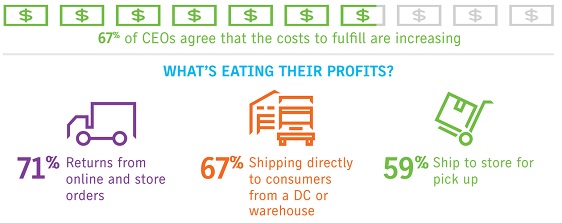How omni-channel challenges impact costs, revenues and responsibilities
PwC CEO survey finds only 19% of top retailers say they can fulfill omni-channel demand profitably.
Latest Material Handling News
Registration open for Pack Expo International 2024 Walmart chooses Swisslog AS/RS and software for third milk processing facility NetLogistik partners with Vuzix subsidiary Moviynt to offer mobility solutions for warehouses Lucas Watson appointed CSO for Körber’s Parcel Logistics business in North America Hyster recognizes Dealers of Distinction for 2023 More NewsAmid heavy investment in omni-channel capabilities among retailers and consumer goods manufacturers, only 16% of companies say they can fulfill omni-channel demand profitably, according to a new study by PwC for JDA Software.
The full report, The Omni-Channel Fulfillment Imperative, is based on a late 2014 global survey of more than 400 retail and consumer goods CEOs. The high cost of order fulfillment is cited as the culprit for eroding retailers’ margins in today’s omni-channel environment. Other main findings from the CEOs’ responses include:
● 66% cited same-day, next-day delivery offering as the #1 threat that keeps CEOs up at night.
● 71% cited omni-channel fulfillment as a top priority for the retail business.
● 88% cited transportation and logistics as a fulfillment capability that needs attention the most.
Moreover, only 19% of the top 250 retailers (and only 16% of all respondents) say they can fulfill omni-channel demand profitably.
Twenty-two percent of responses came from top 250 retailers (> $5 billion revenue), with another 51% classified as top 1,000 retailers. Respondents identified themselves as coming from hard goods, soft goods, CPG, e-commerce and grocery verticals, as well as a few related retail and consumer sectors.

The challenge that CEOs said would be most likely to impact them to a great extent (35%) was failing to meet customer expectations across channels. But close behind this (34%) was failing to re-engineer your business to align with the changing role of the store. Tied for third greatest threat (33%) was failing to manage the costs of fulfilling omni-channel expectations.
While retail CEOs recognize these challenges, they still appear more focused on revenue growth than profitability. When asked to rank their top initiatives for improving business operations over the next 12 months, the number one choice (57%) was spending capital on creating new customer experiences, closely followed (56%) by using stores as fulfillment centers for faster deliveries of online purchases. Similarly, when asked to rank strategic growth enablers for the year, reducing/ reformatting physical store footprints to focus on expanding their e-commerce business was the top choice at 53%.

CEOs also realize that positioning the right inventory and assortments close to customer delivery points is critical for achieving customer satisfaction and profitability. In fact, more CEOs (52%) ranked improving inventory availability while controlling cost as their top organizational priority than any other objective.
“Previous siloed approaches cannot achieve these dual objectives,” the report’s authors wrote. “In fact, planning for merchandising, product positioning, shelf space and inventory management while executing flexible fulfillment options was, along with enterprise inventory visibility, the organizational priority most cited by CEOs that they could not currently deliver.”
When asked who would own omni-channel fulfillment strategy and investment over the next three to five years, there was a fairly even split among executive level positions. Twenty-seven percent said the head of ecommerce/digital would own it, reflecting traditional views that omni-channel stems from digital channels. Twenty-six percent felt the head of supply chain should own it, demonstrating the rapid rise in importance of the supply chain function in an omni-channel world.
Finally, 25% said the CEO would own this strategic function. This is an interesting finding because it indicates that the importance of omni-channel fulfillment in overall corporate success is recognized at the highest level of the organization.

Article Topics
Latest in Materials Handling
Registration open for Pack Expo International 2024 Walmart chooses Swisslog AS/RS and software for third milk processing facility NetLogistik partners with Vuzix subsidiary Moviynt to offer mobility solutions for warehouses Materials Handling Robotics: The new world of heterogeneous robotic integration BSLBATT is looking for new distributors and resellers worldwide Lucas Watson appointed CSO for Körber’s Parcel Logistics business in North America Hyster recognizes Dealers of Distinction for 2023 More Materials HandlingSubscribe to Materials Handling Magazine

Find out what the world's most innovative companies are doing to improve productivity in their plants and distribution centers.
Start your FREE subscription today.
April 2024 Modern Materials Handling

Latest Resources










